
by Fronetics | Jun 11, 2019 | Blog, Content Marketing, Logistics, Marketing, Social Media, Supply Chain
An effective social media strategy requires data. Here are our 10 favorite social media analytics tools to empower you with insights that will boost your social media game.
Highlights:
- Hootsuite and Sprout Social are all-around social media management tools that offer analytics.
- Google Analytics is an overall powerhouse tool to track the performance of all your digital assets.
- Newcomers to the list include Awario, Squarelovin, Keyhole, and image analytics tool PixL.
At Fronetics, we believe in a data-driven approach to digital marketing. A solid analytical framework has the potential to offer insights that will shape and refine your strategies, increasing your ability to generate, nurture, and convert leads. We’ve pulled together 10 of the best social media analytics tools to help you determine what’s working and what’s not — and to empower you to develop a data-driven strategy.
Our 10 favorite social media analytics tools
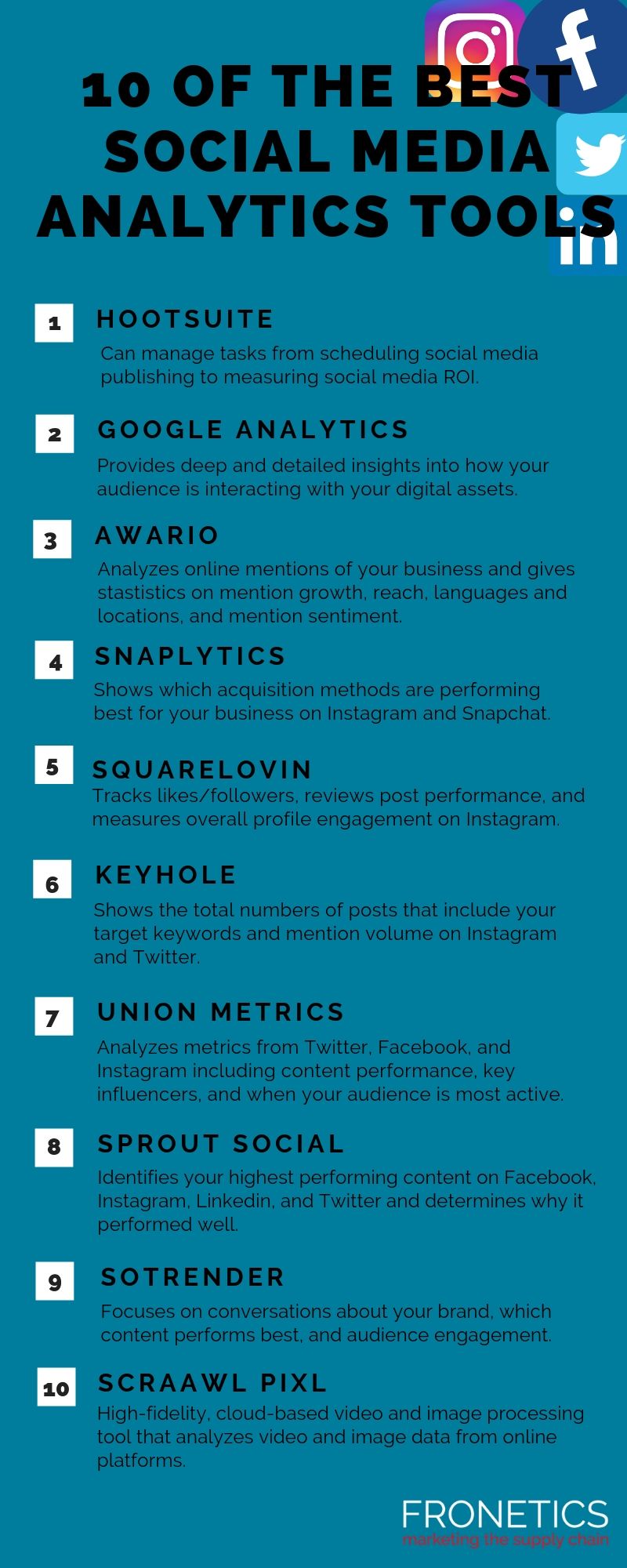
(Made with Canva)
1) Hootsuite
There are so many tools out there, and our internal list of the best social media analytics tools often shifts. But there are a few platforms that always make the list, and Hootsuite is one of them. It’s one of the most popular social media management tools for a reason – it’s a powerhouse that can manage tasks from scheduling social media publishing to measuring social media ROI.
Hootsuite gives you key metrics from Twitter, Facebook, and Instagram with audience and post insights, as well as performance data. It packages all the data in approachable charts and graphs. One of our favorite features is the AutoSchedule tool, which lets Hootsuite determine the optimal time to post or tweet based on when similar content performed well in the past.
2) Google Analytics
Another of our perennial favorites, Google Analytics is a robust platform that can provide deep and detailed insights into how your audience is interacting with your digital assets, including social media. This is one of the best social media analytics tools out there, and we’ve written extensively about how to get the most out of it.
For social media analytics, we particularly recommend three custom reports: Best Days to Post on Social Media, Best Time to Post on Social Media, and the Social Media Traffic by Date and Hour. These three reports offer real-time data, along with the in-depth insight you need to help your business optimize its social media strategy.
3) Awario
Awario analyzes online mentions of your business and gives you statistics on mention growth, reach, mentions’ languages and locations, mention sentiment, and where on the web mentions are occurring. We particularly appreciate that the tool also identifies social media users who have used your keywords and provides you with a list of social media influencers in your specific area.
Benchmarking your social media marketing strategy against your competitors is key to understanding how you’re doing. Awario lets you create alerts for your main competitors and offers you a step-by-step comparison of your social media performance against theirs.
4) Snaplytics
While all-inclusive tools like Hootsuite and Google Analytics are excellent for evaluating your overall social media strategy, we also recommend a few tools that focus on specific platforms. Snaplytics hones in on Instagram and Snapchat, including offering insights on Instagram Stories.
For both networks, Snaplytics shows you which acquisition methods are performing best for your business, as well as what precipitates rises and falls in engagement levels. Snapchat can be a tricky platform for brands, and Snaplytics provides the kinds of insights you need to make inroads on this millennial-dominated network.
5) Squarelovin
We’ve written extensively about how supply chain companies can make the most of Instagram and Instagram Stories. Squarelovin is an analytics tool specifically for Instagram that provides you with the data you need to optimize your strategy. It tracks likes and followers, reviews post performance, and measures overall profile engagement.
One of the best social media analytics tools for Instagram out there, Squarelovin highlights the best times to post, ideal filters to use, and most popular hashtags. It also gives you a history of engagement with your posts, broken down by hour.
6) Keyhole
This social media monitoring tool offers up deep analytics for Twitter and Instagram. Keyhole will show you the total number of posts that include your target keywords, as well as how mention volume has changed over time. It displays engagement data, hashtag usage trends, sentiment metrics, and reach statistics.
Influencers are key on Instagram and Twitter, and influencer marketing should be part of your social media strategy. Keyhole provides insights into influencers and trends in your specific niche, along with audience demographics and locations.
7) Union Metrics
Union Metrics analyzes a range of metrics from Twitter, Facebook, and Instagram. Like Hootsuite, it lets you know which content is performing best across each platform, the times when your audience is most active throughout the day, and who your key influencers are.
What really sets Union Metrics apart is in its potential for optimizing content creation. The tool goes above and beyond by tracking relevant trends to help you generate ideas for new content, based on hard performance data.
8) Sprout Social
Sprout Social is probably Hootsuite’s biggest competitor, and it’s another of our frequent favorites. Like Hootsuite, it’s an all-around social media management tool that provides key analytics as well. It measures performance and engagement across Facebook, Instagram, LinkedIn, and Twitter and benchmarks your data against competitors.
Sprout Social also helps you identify your highest performing content and determine why it has performed well. It can also show you how your paid ads are performing through a comparison of paid versus organic impressions and followers gained.
9) Sotrender
This formidable social media analytics tool shows you where conversations about your brand are happening, which of your content performs best, and how your audience engages with your social media content. Sotrender analyzes Twitter, YouTube, Facebook, and Instagram and makes it easy for you to benchmark your efforts against your competitors.
We like any tool that not only offers data but gives you advice for improving your strategy. Sotrender offers customized tips on where your marketing strategy needs improvement, based on the analysis it performs.
10) Scraawl PixL
As the internet, and social media in particular, becomes more visual, experts have pointed to a dearth of analytics tools with the capability to perform rich analysis on images. Scraawl PixL is a relatively new kid on the block, and it’s attempting to fill the void when it comes to image-based analytics.
This high-fidelity, cloud-based video and image processing exploitation tool offers an easy-to-use interface, as well as workflows for analyzing video and image data from online digital platforms. It relies on machine learning-based algorithms that enable face detection and recognition as well as object detection, tracking, and classification.
What are your favorite social media analytics tools?
Related Posts:
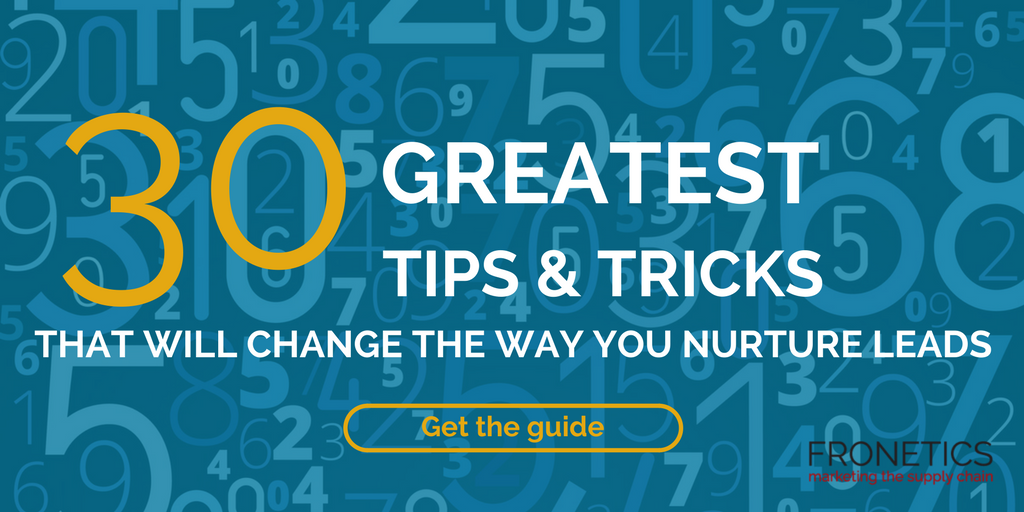

by Fronetics | Jun 5, 2019 | Blog, Content Marketing, Logistics, Marketing, Robotics & Automation, Social Media, Supply Chain
When it comes to digital marketing, social media is here to stay. Here’s our four-step guide to leveraging social media for the robotics industry.
Highlights:
- Having a documented strategy is key to reap the benefits of social media marketing.
- Define your audience and establish concrete goals for social media campaigns.
- Set metrics and use data to adjust your strategy consistently over the long term.
The demand for high-performance robotic systems is growing steadily and showing no signs of slowing down. In fact, New Equipment Digest predicts that the robotics vertical within the materials-handling-equipment sector will grow by over 8%, reaching $20 billion by the year 2024. To capture the benefits of the sector’s growth, robotics companies need to invest in digital marketing. Social media for the robotics industry holds tremendous potential — if it’s leveraged properly.
In our work with clients across various verticals in the supply chain, including robotics, we frequently hear that they have been skeptical about the potential of B2B social media use. While social media management does require time and resources, robotics companies should absolutely be reaping the benefits of social media marketing.
Read on for tips on how to create a strategy and leverage social media for the robotics industry.
4 steps to developing a strategy for social media for the robotics industry
1) Define your audience.
For supply chain companies, one of the biggest predictors of success in a social media marketing campaign is a clearly documented strategy. A big part of that is defining your target audience. Chances are, you have some target buyer personas already. Keep these top of mind as you create your social media strategy.
What are the unique needs and challenges faced by your audience? Where do they go online for information? What are their goals? What do they value from you? The more you ask and answer questions about your audience, the better positioned you are to create a strong and effective social media strategy.
2) Determine your goals.
Next, consider what your goals are on social media. You’d be surprised how often this step gets skipped. Marketers are often pressed for time or resources and think of social media marketing itself as a goal, rather than defining specific, measurable objectives for their social media campaigns.
[bctt tweet=”When it comes to social media for the robotics industry, common goals often include increasing brand awareness and authority, generating leads, or establishing thought leadership.” username=”Fronetics”]
When it comes to social media for the robotics industry, common goals often include increasing brand awareness and authority, generating leads, or establishing thought leadership. But before you embark on a social media strategy, consider what your company specifically needs to achieve.
3) Define your metrics.
One of the best things about having documented goals for your social media strategy is that it helps you define what metrics you should be using to track your progress toward those goals. Measuring social media ROI is no easy task, but there are plenty of tools and strategies that can help. While your full list of metrics will be determined by the goals you set, robotics companies should be tracking at least these four metrics:
- Where traffic is coming from
- Revenue derived from posts
- Visitor behavior on your site
- Social media conversions
In addition to the analytics tools offered by social media platforms like Facebook, Twitter, Instagram, and LinkedIn, Google Analytics can give you a bird’s eye view of your social media efforts, as well as delving into detail on the metrics that matter most to you. For more, be sure to check out our guide to getting the most out of Google Analytics.
4) Choose your platforms.
Not all social media platforms are created equal. When it comes time to choose your social media platforms and create a strategy for each, it’s important for robotics companies to consider where their audience spends their time online (see step 1).
As you identify what social media channels are the best fit for your company, keep in mind that the characteristics of each platform should inform what content and how often you should be posting. Twitter, for example, lends itself to short-form, pithy content or links and frequent posting, while a more visual platform like Instagram only requires 1-2 posts per day.
Going forward: using your metrics to stay agile
Once your strategy is established, you can simply put it into place, start posting content, and forget about it, right? Wrong. Effective use of social media for the robotics industry requires ongoing evaluation and adjustment.
If you’ve defined the right metrics to track, the data you collect should help you determine where your efforts are successful and where your methods need to be adjusted. As you refine your strategy and learn the needs and preferences of your target audience, you’ll find that social media is an extremely effective tool for capturing leads, broadening your brand’s reach, and building your reputation.
Related posts:
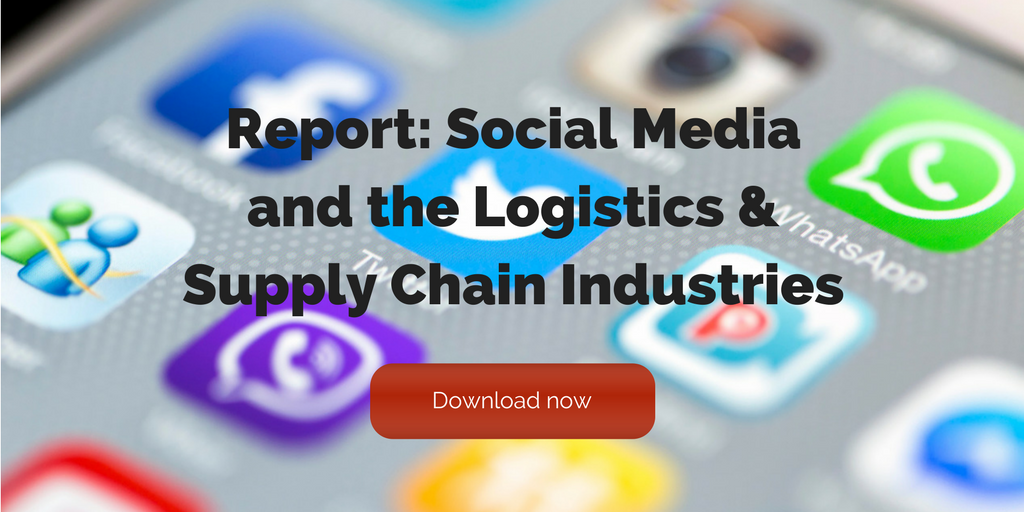
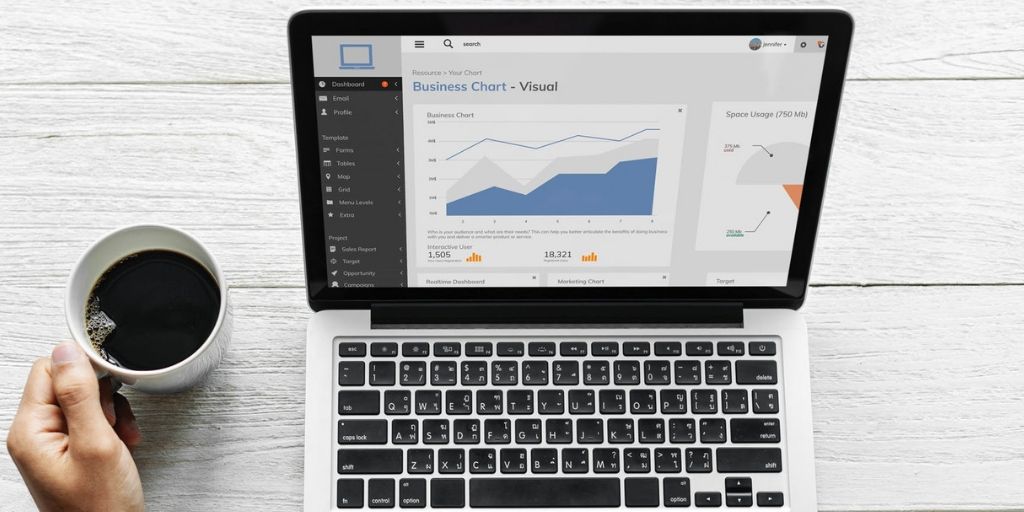
by Fronetics | May 29, 2019 | Blog, Content Marketing, Data/Analytics, Marketing
These Google Analytics reports are crucial to understanding the visitors who are browsing your website and how you are more likely to get them to convert.
Highlights:
- Audience reports tell you who is visiting your website.
- Acquisition reports convey how are users getting to your website.
- Behavior reports show what visitors are doing on your website.
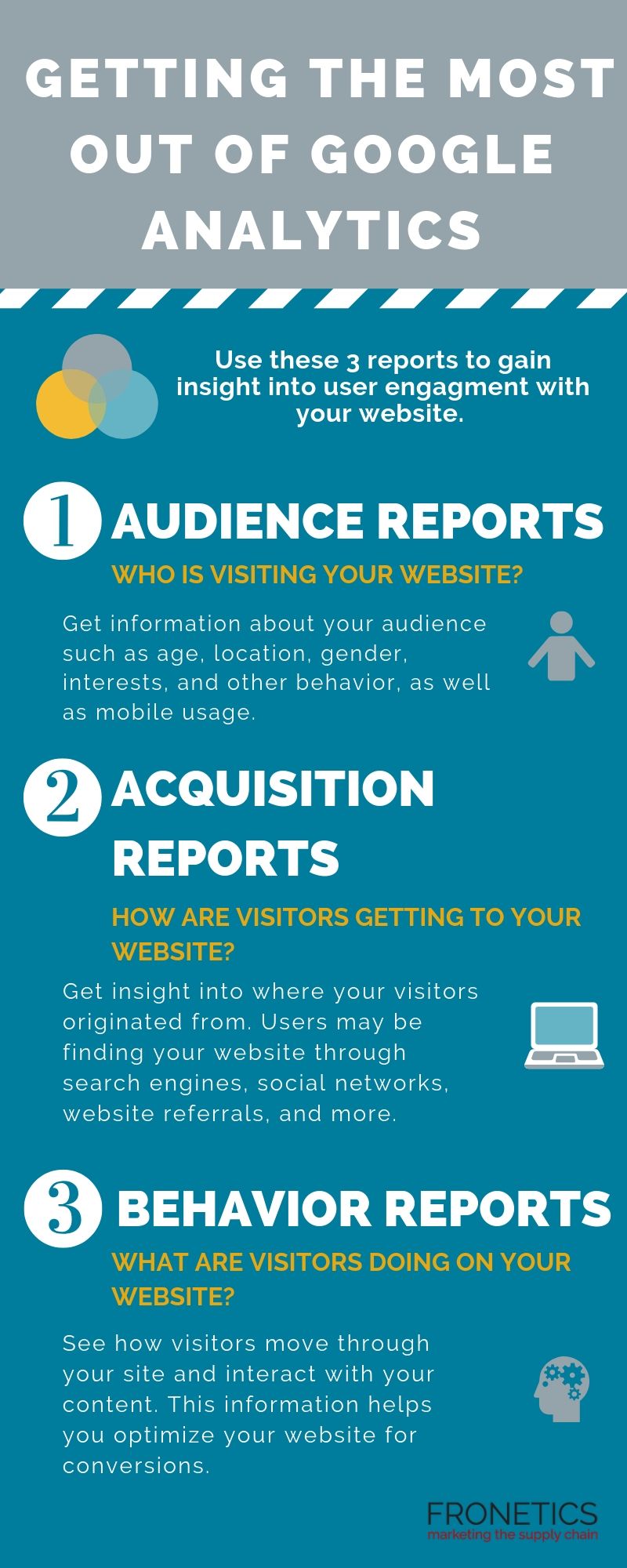
(Made with Canva)
Your website is your best opportunity to convert digital prospects into leads. But how can you learn who is browsing your website and what they are doing while they’re there? Most importantly, how can you get more of them to convert? Here’s where tools like Google Analytics can help.
Google Analytics is one of if not THE most comprehensive analytics tools available to digital marketers. But it can be very overwhelming if you don’t know how to navigate it. So, we’ve come up with the 3 Google Analytics reports you should be running if you want to understand how to get more visitors to convert on your website.
But, first, let’s start with the basics.
Understanding Google Analytics
At a fundamental level, Google Analytics helps you understand and make decisions based on the traffic that comes to your website. This free tool is a powerhouse that uses a JavaScript code to collect data surrounding how users interact with your website. It then processes that data and generates customizable reports for you within the platform.
[bctt tweet=”This free tool is a powerhouse that uses a JavaScript code to collect data surrounding how users interact with your website. It then processes that data and generates customizable reports for you within the platform.” username=”Fronetics”]
I should say: the data you gain from Google Analytics is all the richer if you begin by setting up Goals on the platform. This way, Google Analytics can go to work for you, measuring how well your website is fulfilling your specific objectives. If you start by properly setting and configuring your goals, Google Analytics can provide you with critical information that’s specific to your strategy. Of course, you can always add to or adjust your goals, as you collect data.
Getting the most out of Google Analytics can empower you to make improvements to your website based on the data it collects for you. The more information you have about your site and its traffic, the more you can make adjustments to meet your objectives. Furthermore, the insights you gain from your metrics can help shape future objectives, to improve user experience on your site.
3 Google Analytics reports that are key to getting the most out of the platform
Using Google Analytics, you can gain insight into some of the most important questions surrounding user engagement with your website. In particular, these 3 reports are helpful in getting the most useful data for understanding lead conversion opportunities:
- Audience reports: Who is visiting your website?
- Acquisition reports: How are users getting to your website?
- Behavior reports: What are website visitors doing on your website?
Here’s what you need to know about each report.
1) Audience reports
As you create and publish content on your website, you need to know who’s reading/watching/viewing/listening to it. With Google Analytics, you can get information about your audience such as age, location, gender, interests, and other behavior.
As users are increasingly engaging with websites on mobile devices, we often encourage clients to monitor the Mobile report as well as other audience demographics. This report shows you what percentage of your audience comes from a mobile device, as compared to a desktop or tablet. You need this information, particularly because mobile device users tend to have different behavior and goals from those on desktops. If your traffic is heavily mobile, your site needs to be optimized for these visitors.
We also encourage clients to make use of Google Analytics’ audience benchmarking reports. These reports allow you to compare your results with aggregated industry data, giving you the context you need to set targets. Benchmarking can also give you insights into industry-wide trends and help you determine how you’re doing as compared to your competitors.
2) Acquisition reports
Knowing how visitors are getting to your website will empower you not only to improve your site, but to make strategic decisions surrounding your other digital channels. Google Analytics offers acquisition reports that provide insight into where your visitors originated from. Users may be finding your website through search engines, social networks, website referrals, and more.
Use the Acquisition Overview to get a quick overview of the top channels that are funneling visitors to your website. You can also see associated acquisition, behavior, and conversion details for each of these channels. If you have your Google Analytics Goals in place, the Acquisitions Overview report will display how well each channel is driving conversions.
Next, take a deeper dive in the Channels section, which gives you rich information about each of your channels. For example, if you click on the “Organic Search” channels, Google Analytics takes you to the Keywords report, which lets you know how you’re faring with specific search queries. Clicking the “Direct” channel will take you to the top landing pages for direct site visitors, and “Social” shows you your top-referring social networks.
3) Behavior reports
Once visitors are on your site, what are they doing there? If you’re getting the most out of Google Analytics, you can see how visitors move through your site and interact with your content – and, in turn, you can be strategic about optimizing your website for conversions.
Start with the Behavior Overview. Here, you’ll find a graph of the amount of traffic your website receives, as well as additional metrics such as Pageviews, Average Time on Page, Bounce Rate, and more.
For more insight, the Behavior Flow report shows you the path users typically take on your website. You can see the first page they view, all the way to the final page they typically visit before exiting your site. Here, you’re getting a visual of how long visitors stay on your website — and learn a bit about why they leave.
The bottom line: Google Analytics reports help you optimize your website
Data empowers you to make informed decisions and tailor your strategies to meet your objectives. Not only that, data can help you determine your objectives in the first place. Google Analytics is perhaps the most robust tool out there for gathering information and insights into essentially every aspect of your website. Make sure you’re making use of it.
What Google Analytics reports have you found most helpful?
Related posts:


by Fronetics | May 22, 2019 | Blog, Content Marketing, Logistics, Marketing, Social Media, Supply Chain
Social listening describes the process of scanning online platforms to find the sentiment around your brand. Here are 4 ways that social listening can boost SEO.
Highlights:
- Social listening describes the process of scanning social media platforms, blogs, news websites and other digital forums to find the mention of any keywords.
- Regularly monitoring the sentiment around your brand through social listening can help prevent a problem before it blows up.
- Track your organic brand mentions and use that information to create a strategy about how to grow brand awareness.
Video transcript:
This is Elizabeth Hines. I’m the Creative Director at Fronetics, and today we’re talking about four ways social listening can boost your SEO.
Social listening describes the process of scanning social media platforms, blogs, news websites and other digital forums to find the mention of any keywords. In particular the name of your company or your CEO for example, to figure out the general sentiment around your company and your people. We used to use social listening mainly for social media marketing, but it can also be a really effective search engine optimization tool if you do it properly. So here are four ways social listening can boost your SEO.
1. Learn if your backlinks are coming from spammy websites
Backlinks from spammy or untrustworthy websites can negatively impact your search ranking. So a Google executive recently noted that this is just a normal part of being on the web and really you shouldn’t worry that much about it. But the one exception would be if there’s some kind of dedicated activity from a competitor, for example, buying up a lot of links and trying to ruin your search ranking. In this instance you should consider disavowing them and using social listening to figure that out.
2. Find guest blogging opportunities
One of the greatest benefits of social media is the opportunity to network with your industry peers and social influencers. Building relationships with reputable businesses and people could be a gateway to guest blogging, which is one of the most sound and effective ways to build your reputation with search engines, not to mention the people that follow those peer sites and influencers.
3. Monitor your brands reputation
Mistakes happen and even companies with the best intentions will sometimes suffer from a social media crisis. So regularly monitoring the sentiment around your brand through social listening can help prevent a problem before it blows up, goes viral or at least is big enough for Google’s algorithm to down rank you for providing a poor user experience.
4. Grow brand mentions
Now a lot of people will tell you to use social listening to find linkless backlinks, which are websites that mention your content but don’t provide a hyperlink to your site. Then you should reach out to those people and see if they’ll add that link in. But in my opinion, this is an enormous waste of time. We’re seeing that linkless backlinks are becoming equally as important as regular backlinks for search engine optimization. So instead, I encourage you to use that time and energy to track your organic brand mentions and use that information to create a strategy about how to grow more. For example did you say something on Reddit that got lots of attention? Well, you should do more of that.
For more tips like these, check out our blog at fronetics.com.
Related posts:

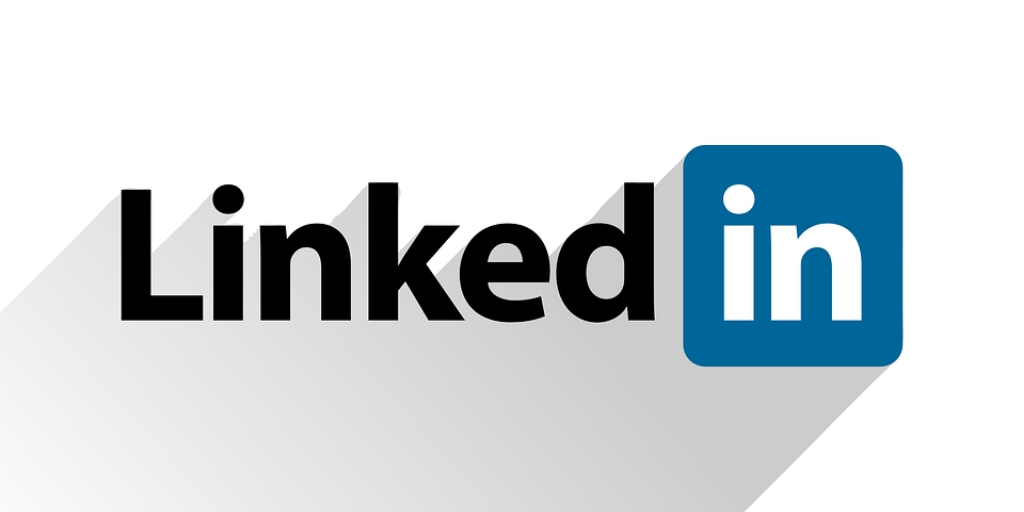
by Fronetics | May 16, 2019 | Blog, Content Marketing, Logistics, Marketing, Social Media, Supply Chain
LinkedIn is a powerhouse B2B social media network and an ideal place for gaining industry insight. Here are 8 must-follow professionals on LinkedIn for the supply chain.
Highlights:
- 94% of B2B marketers are using LinkedIn to distribute content.
- With its publishing platform, LinkedIn lets users create long-form content.
- Follow industry thought leaders to fill your LinkedIn newsfeed with the most up-to-date insights and analysis.
LinkedIn is an overwhelmingly popular platform for B2B marketers when it comes to content distribution. In fact, recent reports indicate that 80% of B2B leads come from LinkedIn, as opposed to 13% from Twitter and 7% from Facebook. The platform isn’t just a powerhouse when it comes to content distribution and lead generation. LinkedIn, for the supply chain, is also an ideal place to keep up with industry news, trends, and thought leadership.
[bctt tweet=”Recent reports indicate that 80% of B2B leads come from LinkedIn, as opposed to 13% from Twitter and 7% from Facebook. ” username=”Fronetics”]
One of the features that sets LinkedIn apart is its Publishing platform. Through the network, users can create long-form posts and articles and share them with followers. This means your LinkedIn newsfeed can become a go-to resource for keeping pace with the latest in-depth industry analysis. Having the right connections in the industry is key to curating the most valuable content for your newsfeed. Here are our 8 favorite professionals to follow on LinkedIn for the supply chain and logistics industry.
Top 8 professionals to follow on LinkedIn for the supply chain
Don Tapscott, Co-Founder and Executive Chairman of the Blockchain Research Institute
A preeminent authority on the impact of technology on business and society, Don Tapscott has written 16 books and has a record of over three decades of thought leadership. In 2017, Tapscott and his son, Alex, co-founded the Blockchain Research Institute, with more than 70 projects doing definitive investigation into blockchain strategy, use-cases, implementation challenges, and organizational transformation. Blockchain has the potential to reshape the supply chain. Tapscott is a great resource for staying ahead of the changes that are coming.
Kelli Saunders, President of Morai Logistics Inc. at Mode Transportation Associates
Recently named as one of Canada’s Top 100 Most Powerful Women, Kelli Sanders is blazing a trail for women in the supply chain. Recognized for her extensive work in the Women’s Executive Network, Saunders actively speaks on encouraging women/young leaders to pursue rewarding careers in entrepreneurship, supply chain, and logistics. In 2016, we were fortunate enough to interview Saunders, who shared her insights on key issues within the supply chain.
Sean Griffey, CEO and Co-Founder at Industry Dive
A recipient of the Digital Hall of Fame and Media News Award, Sean Griffey specializes in strategic growth planning, financial management, technology strategy, online media, lead generation, business development, and B2B media. His company, Industry Dive, publishes business news and original analysis in 12 vertical markets. Griffey continues to run the Logistics and Supply Chain Professionals group on LinkedIn, with nearly 300,000 members.
Tim Debus, President & CEO of Reusable Packaging Association
Tim Debus brings his 20+ years of experience in bringing to market new technologies and leading industry initiatives to improve the production and supply of agricultural commodities. He focuses on promoting the use and value of reusable transport packaging systems and advancing the common business interests of members of the Reusable Packaging Association. He works to clearly demonstrate supply chain efficiencies, environmental benefits, ergonomic improvements, and cost advantages to end users in all industries.
Patrick Bian, Director of Supply Chain Management at Watts Water Technologies
Patrick Bian boasts an impressive track record developing supply chain strategic roadmaps and leading multi-national teams to support the business vision for global companies. In his work at Watts Water Technology, he provides solutions used to safely convey, conserve, and manage water. Standing president of the French American Chamber of Commerce, New England for the past four years, Bian is also a lecturer at Northeastern University for the Masters Program in Business and Engineering.
Yossi Sheffi, Professor of Engineering and Director of the MIT Center for Transportation and Logistics
An expert in systems optimization, risk analysis, and supply chain management, Dr. Yossi Sheffi is a leading academic in supply chain and logistics studies. He has authored numerous award-winning books, consulted with leading entrepreneurs, and founded or co-founded five successful companies. His LinkedIn publications highlight industry trends ranging from autonomous driving to the latest in retail and e-commerce.
Adrian Gonzalez, President at Adelante SCM & Founder/Host of Talking Logistics
Adrian Gonzalez is a well-respected, trusted, and influential supply chain and logistics analyst and strategic advisor to high-level executives in manufacturing, retail, third-party logistics, and technology companies. He is the founder, host, and creative force behind Talking Logistics, a weekly online video talk show. On both LinkedIn and Talking Logistics, he gives supply chain and logistics professionals interactive and engaging information about the industry, focusing on interviews with thought leaders and key players.
Bart De Muynck, Research Vice President at Gartner
Bart De Muynck is a prolific and insightful publisher on LinkedIn, where he analyzes complex technology topics that are currently impacting the transportation sector. He frequently writes about advanced transportation management systems, as well as the many ways blockchain will impact the supply chain industry.
Did we miss anyone? Who are your favorite professionals to follow on LinkedIn for the supply chain?
Related posts:











